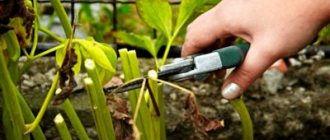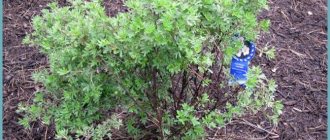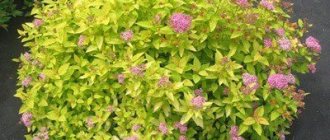Author: Elena N. https://floristics.info/ru/index.php?option=com_contact&view=contact&id=19 Category: Garden plants Published: February 23, 2019Last edits: November 08, 2020
Spiraea Vanhouttei (lat. Spiraea x vanhouttei) is a fast-growing ornamental shrub of the Rosaceae family, a deciduous hybrid between three-lobed spirea and Cantonese spirea. Spiraea Vangutta has been cultivated since 1868.
Diseases and pests and their control
All types of spirea are not often attacked by various pests, but sometimes it happens. Let's get to know some of them.
Spider mite
Perhaps the most formidable among them is the spider mite, since in one growing season 8 to 10 generations of this pest can appear. Whitish paniculate spots appear on the surface of the leaves on which the spider mite has settled. Then the leaves turn yellow, dry out and fall off. The number of spider mites increases especially noticeably from July to August (during hot and dry summers).
To combat this pest, arex (0.2 percent solution), metaphos, fozalon, keltan and phosphamide are used.
Aphid
Also, quite a lot of damage is caused by aphids, which feed on the sap of leaves, peduncles and tender young shoots. It is especially dangerous from June to mid-August.
This pest can be destroyed with solutions of pirimor, actellik, kronefos, fozalon. In case of minor damage, folk remedies will also help, such as tincture of tobacco, capsicum, onion, garlic, and soap solution.
Diseases
In addition to pests, spirea can be affected by fungal infections, such as gray mold and various spots.
. For treatment, fungicidal preparations are used, such as foundationazole, phytosporin-m, ditan m-45, Bordeaux mixture, colloidal sulfur.
Often your attention in city flower beds is attracted by a small ornamental shrub with crimson flowers and yellowish foliage. This is Japanese spirea
It has taken its rightful place in decorating city flower beds and summer cottages due to its low cost, unpretentiousness and preservation of decorative qualities from spring to late autumn.
The effect of pruning on the appearance and development of spirea
Spirea is the type of shrub that responds gratefully to pruning, even serious pruning. Such procedures stimulate both active plant growth and powerful flowering in all varieties, including spring-blooming and summer-blooming varieties.
Lack of regular pruning, on the contrary, will lead to the fact that the bush will look unkempt and turn into thickets with dry branches and weak, unattractive flowering - the bush simply will not have the strength to form new buds. Moreover, if you prune faded shoots in mid-summer (July), the shrub can bloom a second time as early as September! The main thing is not to forget to remove the wilted shoots again in the fall.
Thus, the main advantages of pruning are: a noticeable increase in the splendor of the bush, more abundant or even repeated flowering, giving the bush absolutely any shape, including the geometric shapes characteristic of a hedge. In addition, timely treated shrubs will allow more air and light to pass through. The procedure will minimize the risk of pest attack or diseases due to leaf decay deep in the crown. It is almost impossible to prune spirea incorrectly, so do not be afraid to harm it with this procedure.
Where is the best place to plant
Most spireas love sun, good soil and moderate humidity. In nature, they are part of deciduous and mixed forests, filling the edges and gaps among the trees. Some species thrive on mountain slopes, including screes, covering the altitude range from the foothills to the subalpine belt. There are species, for example, willow spirea, which prefer to settle closer to the water and grow along the banks of rivers, lakes or along the edges of swamps.
Spiraea vangutta is distinguished not only by its beauty, but also by its unpretentiousness. It is frost-resistant and can grow in conditions of contrasting seasonal temperatures. Tolerates strong winds, but only if they are not too frequent. In relation to moisture, it is more drought-resistant than moisture-loving. So this plant needs to be planted in well-lit areas, on slopes or hills where light sandy soil has formed.
To diversify your garden design and bring even more color to it, use different types of shrubs with different flowering times. Here are the options we offer - read.
The decorative properties of this spirea can be used to form the following landscape elements:
- hedges, both around the perimeter of the site and inside it;
- the central element of the composition in combination with a flower garden of low-growing plants;
- cannons near a group of coniferous trees;
- composition framing the entrance to the house.
Spiraea Vangutta "Gold Fountain".
Spiraea Wangutta, like a weeping willow, is notable for its spreading, arched branches that bend downward. Spiraea Wangutta is classified as a spring-flowering plant. Blooms for several weeks.
Autumn pruning of spirea
Pruning is a necessary component of a set of measures for caring for this shrub. It helps maintain abundant flowering and also constantly rejuvenates the bush. The pruning method depends on the age of the bush, the type of plant, and its flowering time.
Some gardeners consider this operation unnecessary. However, without it, the bush will quickly turn into shaggy and sloppy, the shoots will stretch out and become thinner, and the flowers will be crushed. Old dried branches will accumulate inside the bush, which impede air exchange, which will ultimately lead to stagnation of air inside the bush and increased humidity. All these factors can cause fungal diseases.
When to prune spirea - in spring or autumn
Throughout the season, it is necessary to carry out sanitary cleaning of the bush, removing broken and dried shoots. Full pruning is best done in the fall. The only exceptions are the northernmost areas where this shrub is grown. In them, due to the climate, after the autumn pruning, the spirea may simply not have time to recover before the arrival of cold weather. Therefore, in such areas it is pruned in the spring.
Do I need to prune spirea for the winter?
No additional pruning is required as a winter preparation measure. Most species of this plant are winter-hardy and easily tolerate even the most severe frosts. Before winter, it is enough to tie all the shoots into one bunch, bend them to the ground, and then cover them with a layer of mulch and snow. Varieties that are not sufficiently frost-resistant are bent to the ground, fixed, and then covered with a thick layer of fallen leaves, straw or sawdust.
Types and timing of pruning spirea in autumn
For the first few years after planting, the bush is not pruned, as this may worsen the condition of its root system. Starting from 3-4 years of age, the following types of pruning can be carried out:
- Stimulating. This pruning consists of cutting off all woody shoots at a height of approximately 30 cm. This measure stimulates the growth of new side shoots. The procedure is carried out in mid-autumn, before the temperature begins to drop below 0 °C.
- Rejuvenating. This is a type of deep pruning that allows a new bush to actually grow. Rejuvenating pruning is carried out in September-October, completely cutting off all shoots at soil level. This procedure is recommended for old or pest-damaged bushes. In the spring, the spirea will grow again, producing powerful shoots from the buds located near the root collar.
How to prune spirea in autumn
In autumn, the shoots are pruned to the level at which the buds of the woody part are located. At the same time, the formation of the bush is carried out. It is also necessary to remove a few shoots from the interior to maintain normal air exchange and prevent mold from forming.
Pruning summer-blooming spirea in autumn
You can start pruning summer flowering varieties starting from the 4th year of the bush’s life. In summer, shoots can be shortened by one third to stimulate the formation of side shoots and enhance flowering. At the beginning of autumn, sanitary cleaning should be carried out, branches that are growing incorrectly and lagging behind in development should be removed. Once every 7-8 years, it is necessary to intensively thin out the bush, leaving a few of the most powerful shoots, and completely remove all the rest.
Pruning early flowering spirea in autumn
Early varieties bloom on last year's shoots. In the fall, approximately one-fifth of each bush needs to be removed, cutting them off at ground level. This stimulates increased spring growth.
Scheme for pruning spirea in autumn
The spirea bush takes several years to form. In the second year of life, you can start pruning it. It is produced according to the following scheme:
- Diseased, damaged and dry shoots are completely cut out. If the branch is broken, then it is cut back to 1 living bud.
- The tips of young shoots that have not yet become lignified are cut off.
- For bushes older than 5 years, you can begin to carry out anti-aging pruning, removing several adult shoots in order to replace them with young ones.
If after rejuvenating pruning there is no increased formation of new strong shoots, you should think about planting a new plant.
Pruning spirea in the fall for beginners:
Our advantages
12 years on the market
Over the course of 12 years of successful work, we continue to delight our customers with beautiful and healthy plants.
15,000 plant varieties
We offer over 15,000 varieties of seedlings available for regular sale
Better conditions
We offer our own plants at the manufacturer's price with maximum survival rate
Delivery
Daily in-house delivery of plants throughout Moscow and the Moscow region. We ship throughout Russia
We are close
Our plant nursery is located in the northeast of Moscow near the Moscow Ring Road
Exclusive plants
Our assortment includes exclusive plants that only we have
How to plant spirea correctly in the fall
This ornamental shrub looks great both individually and in group plantings. For example, it is often used as a hedge. Before planting, you need to choose a suitable place, and also stock up on a sufficient amount of planting material.
Preparing the landing site
Planted spirea will feel good in an open, well-lit area with loose soil. It must be taken into account that partial shade has a good effect on this plant; it feels better in such conditions and produces brighter flowers, but their number will be less than when grown in open areas.
Sand or peat is often added to loosen the soil. These plants cannot tolerate excess moisture, so wetlands are not suitable for planting them. Coniferous trees get along best with spirea as neighbors.
Preparation of planting material
As a rule, seedlings of this shrub are sold in nurseries or specialized stores. Their root system must be closed, that is, the seedling must have a lump of earth on its roots. It is preferable that it be young and have no leaves, since their presence negatively affects the survival rate of the plant. If the root system of the seedling is open, it must be inspected. The roots should be moist, flexible, without blackness. It is welcome if they are covered with a mixture of manure and clay. The bark of the seedlings should be green and the buds should be alive and healthy.
Rules for planting spirea in autumn in open ground
In autumn, it is allowed to plant spirea for both spring and summer flowering periods. It is better to do this in damp rainy weather, so the plants take root better. The planting hole must be prepared several days before planting. Its size should exceed the volume of the root system along with the lump of earth. The walls of the pit are made vertical. A layer of drainage made of broken brick, expanded clay or crushed stone must be laid at the bottom.
Then an earthen mound is poured in the center of the pit. A seedling is installed on it. If the root system is open, the roots of the seedling are spread along the walls of the earthen mound, and then sprinkled halfway with soil. After this, add a bucket of water to the hole and finally fill it up. The soil is slightly compacted, and a bead of earth is placed around the seedling to prevent water from spreading during watering. After this, the root zone is mulched with peat or humus.
How to transplant spirea to a new place
Spiraea that has not reached 4 years of age can be safely transplanted to another place in the fall. The easiest way to do this is to dig it up along with a lump of earth on the roots, and then plant it in another place. The root system of older bushes is already quite developed, so replanting an adult spirea in the fall will be fraught with certain difficulties. In this case, often not the entire bush is replanted, but only part of it.
Description
The shrub looks luxurious when it blooms, thanks to its flowing shoots covered with snow-white inflorescences. From spring to autumn, a bush with a flowing, spreading or spherical crown also looks decorative, because it is decorated with green foliage with an emerald-bluish tint.
Inflorescences on long shoots gradually bloom in such numbers that the branches begin to bend almost to the surface of the ground and look like lacy snow-white lines.
This variety of spirea blooms again in August, although not as spectacularly as in the first half of summer.
Let's look at the photo and description of the spirea Vangutta shrub in more detail.
Table 1.1 - Description of decorative perennial
| Characteristic | Peculiarities |
| Height | Range 0.7-2 m. The crown is spreading, spherical or cascading. The diameter of the bush is 3 m. |
| Escapes | Curved branches flow from the center to the periphery. But there are subspecies with erect shoots. |
| Leaves | The shape of the leaf with teeth is obovate, there are up to 5 lobes. The length of the leaf is 3-3.5 cm. The outer side of the leaf is dark green with a hint of emerald, and the lower part is bluish in color. In autumn the leaves are colored red-purple. |
| Inflorescences | Flowering in the last ten days of May for 20-35 days. The snow-white inflorescence is represented by a dense hemispherical umbrella. Inflorescences are formed on branches that are over 2 years old. |
| Flowers | The buds open with white petals, the core of the flower is yellow. |
| Fruit | Multi-seeded leaflets are fruits that ripen in September. |
The ornamental plant can be planted in partial shade, but the flowering will not be intense. And although the shrub cannot withstand a significant drop in air temperature, it is capable of very rapid recovery after freezing.
Types and timing of shrub pruning
Throughout the growing season, meadowsweet must be periodically pruned. This plant is so plastic that it can be easily shaped, and reacts very positively to pruning, throwing out more powerful shoots and forming a larger number of inflorescences. Thanks to shearing, it is possible to achieve an increase in the decorative value of the crop, because meadowsweet is a fast-growing species. It produces a lot of root shoots and shoots, so without timely trimming it will become a sloppy bush.
Depending on the goals pursued, spirea pruning is divided into the following types:
- sanitizing;
- stimulating;
- formative;
- rejuvenating.
Meadowsweet shoots are short-lived and after 1-2 years they begin to dry out. If you leave them on the bush, the branches will become a haven for pests and a breeding ground for fungal spores. Some types of shrubs do not tolerate frost very well; the tips of the branches freeze slightly. To protect the crop from diseases and restore its decorative appearance, gardeners remove diseased, dry, broken branches throughout the growing season. Frozen shoots are cut out in the spring before the buds open.
Stimulating haircut is used for early flowering meadowsweet over 3-4 years old. By removing weak shoots, branching is stimulated and flowering is enhanced. This approach will improve illumination and ventilation of the crown, which will have a beneficial effect on the health of the crop. Stimulating haircut is carried out in early autumn.
The formation of shrubs is usually done in spring or autumn. The autumn period is less busy for gardeners, so the spirea crown is most often formed in the fall.
A shaping haircut can be moderate or dramatic. In the first case, the silhouette of the bush is simply slightly adjusted, in the second, so many branches are cut off so that the crop takes the desired shape.
Plants older than 15 years will need anti-aging pruning. From this age, biological aging begins, the bush gradually loses its attractiveness. Autumn pruning is done 2-3 weeks before frost, so that the wounds have time to heal.
Spiraea - should it be pruned for the winter?
Spiraea is an ornamental flowering shrub that belongs to the Rosaceae family and grows primarily in the northern hemisphere in the temperate climate zone.
There are up to 25 of its representatives in Russia. The plant attracts both amateur gardeners and professional landscape designers with its beauty and ease of care.
This article will tell you whether it is necessary to prune spirea for winter and other seasons.
Pruning spirea is a necessary part of care
There are several types of spirea pruning, each of which has its own purpose. The three main ones are rejuvenating, stimulating and aesthetic (giving a bush or hedge the desired shape).
Spiraea responds very well to pruning, so it should be done regularly. Regardless of the variety and flowering time, “trimmed” plants give visible growth and bloom more luxuriantly. If you cut off shoots that have already bloomed in July, the bush may delight you with secondary flowering in early autumn.
Neglecting care will lead to sloppiness and unpresentable appearance of the spirea. In addition, an overgrown bush becomes weak and almost no new buds are formed on it. Therefore, the benefits, and even the need, of circumcision are obvious:
- the bush becomes lush;
- there are more flowers on it;
- you can give the plant the desired shape;
- a thinned bush receives more light;
- the risk of diseases and pest attacks is noticeably reduced.
Experts say that it is almost impossible to spoil a plant by pruning, so even novice amateurs should not be afraid to do it.
Pruning spirea in autumn
It is relevant for adult plants that have reached three to five years of age. Pruning is done a couple of weeks before the onset of frost - during this time the wounds will dry out and heal, and the plant will gain strength to survive the winter.
The stimulation operation is carried out with pruning shears. Old, unhealthy branches are cut off almost at the root. On the remaining shoots, five buds are left. In the spring, the plant will expel young shoots. In addition to stimulating growth, the crown is thinned in this way.
Bushes that have “crossed” the seven-year mark rejuvenate in the fall. To do this, all shoots are cut to 30 cm from the ground. In the spring, young branches will begin to grow, and the spirea will quickly restore its volume and beauty. In addition to rejuvenation, this also achieves a cosmetic effect - a plant that is not pruned in time loses its attractiveness, because old branches begin to bend towards the ground and spoil the whole view.
Pruning spirea Vangutta
The timing of pruning also depends on the flowering time of the spirea. The Vangutta variety is an early flowering variety, so it is recommended to prune it immediately after the flowers fall off. At the same time, weak and intertwined branches are cut out.
The autumn procedure is mandatory. It consists of completely (at the root) removal of a fourth or fifth of all shoots. Spring pruning is also necessary if the winter was cold and the plant froze.
Then, before the leaves form, the dead tips of the branches are removed.
Spiraea japonica
Pruning Japanese spirea
The flowering period of this species of spirea occurs in the summer. In the first year, flowers form on growing shoots, the next year the side shoots bloom, and the tops of the old ones dry out. Therefore, after three years, the top of the old branches is cut off so that the bush does not lose its shape and does not begin to droop towards the ground.
Since the plant blooms late, it is recommended to cut it at the beginning of the season. Pruning is done to the buds. Weak shoots are removed. To rejuvenate the bush, it needs to be cut very short periodically. To prevent the plant from becoming depleted, pruning is done as the flowers die.
Pruning spirea in spring
Spring pruning of spirea is in the nature of prevention and recovery. First of all, dead branches, as well as those that have dried out during the winter, are pruned.
The purpose of the procedure is, among other things, the formation of the crown, although it is recommended to improve the hedge in the fall in the second year after planting. The main rule of spring manipulation: pruning is done before the leaves begin to form.
In addition, bushes that bloom in spring are pruned as individual branches finish flowering.
For all its unpretentiousness, spirea, like any other garden plant, requires care. The complex process includes fertilizing, watering, mulching, weeding and, without fail, spring and autumn pruning. The work put into it will lead to an excellent result - the skillful hands of the gardener will give it the desired shape, and the shrub will delight you with elegant flowering.
, please select a piece of text and press Ctrl+Enter.
Application in landscape
At a summer cottage, spirea Vangutta is often planted near bodies of water, especially with a weeping crown shape, which harmonizes with the water and gives the bush a spectacular appearance during flowering. A good combination of this perennial with coniferous crops, for example, thujas and spruces.
Landscape experts recommend different options that will allow the beautifully flowering perennial shrub to look most advantageous on the site:
- Spiraea Wangutta in landscape design in the middle of a flower bed, in an alpine hill, among inhospitable boulders or in the center of a parterre lawn;
- as a living and beautiful fence that can replace a fence or zone a site. Shrubs can be used to grow both clipped and free-growing hedges of varying heights;
- as decoration for unsightly places in the garden;
- in group compositions among other shrubs. For example, among lilac, jasmine;
- become a decoration for a recreation area or sports ground;
- tall varieties can create shade near a gazebo, arch or pergola.
Of course, these are just a few options for decorating a dacha. Having shown your imagination, it is easy to create any original composition by planting Vangutta spirea varieties that bloom at different times in one area.
Larisa Nikolaevna Shirko
A gardener with extensive experience ready to answer the most difficult questions
Ask a Question
Is it necessary to prune spirea Wangutta, since it blooms on last year’s shoots and sets buds last season? Let's take a closer look at the pruning situation. 1) Most of the spireas that bloom in spring require only sanitary, so-called. cosmetic trimming. Weak, old and frozen branches in winter are removed;
2) Most early-flowering species of these plants grow many shoots that must be removed so as not to get an impenetrable thicket;
3) Single bushes need to create a strong skeleton. To do this, cut off ¼ of the shoots at ground level in the fall;
4) The bush is trimmed starting at the end of August. It's important not to overdo it. Future flowers have already been laid and therefore annual growth is cut off by only 1/3, which stimulates tillering and subsequent flowering;
5) Unbranched branches of Vangutta spirea are cut by 1/2, cutting off 1/3 of the growth at each fork.
Recommendation! In spring, pruning should not be carried out, otherwise you can lose a lot of inflorescences. In spring, only frozen tips and stems broken by snow are cut off.
Spirea pruning
Now let's talk about pruning, which differs for summer-flowering and spring-flowering spirea, since the inflorescences of these groups are formed on shoots of different years.
Pruning spring-flowering spirea
- In spireas that bloom in May-early June, flower buds are evenly laid along the entire length of the shoots, but they bloom only the next year. Therefore, pruning such spireas comes down to shortening frozen and dried shoots. It is usually carried out annually in early spring (March to April).
- Mature old branches and thin shoots are removed once every two years in the spring.
- Also, such bushes undergo anti-aging pruning. To do this, old branches (over 7 years old) are cut out completely.
Pruning summer-blooming spireas
In plants that bloom in July–August, inflorescences form at the ends of the shoots of that year. The next year, these inflorescences dry out, and new flowers form again on the young shoots.
- Shrubs of this group are pruned in early spring, at the very beginning of the appearance of leaves. Each well-developed branch is shortened to powerful buds, and small and too thin shoots are cut out completely.
- After the fourth year of cultivation, it is advisable to prune the bushes at a height of 25-30 cm.
Varieties
Spiraea Vangutta has several decorative forms:
- Snow White - white spirea Vangutta;
- Pink Ice - young leaves of this variety are decorated with white and pink spots, and the apical inflorescences are cream-colored;
- Renaissance - spirea, characterized by high resistance to disease;
- Spiraea Wangutta Gold Fontaine is a new plant variety of Polish selection. This is a spreading, slowly growing shrub up to 120 cm high with a crown diameter of about one and a half meters. The white flowers of plants of this variety are collected in corymbose inflorescences.
When is it better to prune spirea - in spring or autumn?
People call spirea the bride
For such a sign to correspond to reality, it is important to form the bushes correctly and at the right time. Many gardeners and professional designers love the plant for its abundant and long-lasting flowering, airiness and tenderness that it brings to the urban and garden landscape.
You have already seen what to do with spirea in the fall. Is it possible to cut it in the spring? Without a doubt! In April, summer-flowering varieties of this ornamental plant are pruned. To form a beautiful bush in the spring, take the following steps:
- In the first year after planting, shoots are shortened by half. The branches are cut to the bud, which is directed outward.
- After flowering, the inflorescences are cut off, thus stimulating the growth of side shoots. The plant blooms continuously.
- In the second year, again in April, the shoots are cut to half their length, and in the summer the wilted inflorescences are removed.
- In the third year, they do the same procedure, only in the spring they also remove the old shoots to the ground.
The ancient Greeks admired the grace and sophistication of the thin curving branches of spirea. Breeders have developed many types of their favorite ornamental crops. Among them are weeping, hemispherical, pyramidal, creeping, and dwarf spirea. Most of them tolerate winter frosts well. In severe winters, some species may freeze, so these branches are pruned in the spring. For varieties that are very afraid of frost, the tops of the branches are tied into a bundle, bent to the ground and covered with dry leaves. Take care of this unpretentious plant in spring and autumn, and it will delight you with delicate clouds of flowers.
Preparing for winter
Spiraea Vangutta is a frost-resistant plant. And the bush can freeze completely if the temperature drops for a long time – 45°C and below. But such frosts are rare in the middle regions. Therefore, gardeners do not prepare shrubs for winter. Just mulch the tree trunk area!
But in the northern regions, decorative crops are insulated for the winter. Especially young plants.
To cover them, the branches of the bushes are tied into a bundle, and then wrapped in non-woven material or covered with spruce branches.
Spirea. Care
Despite all their visual attractiveness, spirea are quite unpretentious and grow and bloom well under the most ordinary conditions - loose fertile soil, good lighting, no stagnation of water, fertilizing with a complex of mineral fertilizers 3 times per season and winter shelter for young specimens or for especially tender varieties. The only subtlety when growing spirea is proper pruning.
- Spring-flowering spireas practically do not need pruning, with the exception of sanitary pruning, when old (over 5 years old) shoots, dry and broken branches, and shoots frozen over the winter are removed. Pruning is carried out immediately after flowering, but there is no need to shorten faded shoots, as this will cause increased growth of lateral branches, at the ends of which the inflorescences will be small and inexpressive. And most importantly, the shape of the bush will be disrupted and the effect of drooping flowering branches down to the ground will be spoiled.
- Summer-flowering spirea are pruned in early spring, starting from the fourth year of life, at a height of 20-30 cm from the ground. If this is not done, then the bush will gradually lose its shape, as the old branches will begin to deviate from the center of the bush, laying on the ground. And if you cut only at the tops, the plant will produce thinned young shoots with small, unattractive inflorescences. If you are still afraid of short pruning, then as an experiment you can trim exactly half of the bush and leave the other half alone - and in the middle of summer you can compare the results.
Tips for caring for a bush
To ensure that the flowering is abundant and the arguta does not lose its decorative beauty, it is worth using a few simple recommendations for caring for the plant.
Relation to temperature
Arguta can withstand summer heat and winter frost quite well. Even 40-degree frost will not be destructive for the plant. It is enough to cover it with foliage, as well as follow the basic principles of pruning, watering and fertilizing the soil, and carry out these manipulations in a timely manner in accordance with the temperature regime.
Soil and fertilizers
Arguta does not require frequent application of fertilizers to the soil. If nutrients were added during planting in sufficient quantities, then this volume will be enough for 1 year. Additionally, you need to apply fertilizer only after cutting off all the shoots almost to the root. To give the spirea strength, prepare a nutritious mixture of organic matter (50-70 cm thick) and mineral fertilizers (for example, “Kemiry”).
Watering and humidity
Spiraea needs to be watered systematically, but soil moisture should be moderate, this is especially important with mulched soil. During the summer heat or during a drought, watering is performed 1 time/3 days, and in normal weather and moderate precipitation - 1 time/1 week
Typically, approximately 15 liters of water are used at a time to moisten 1 bush. At the end of watering, the soil is mulched to prevent the formation of a crust on the soil surface.
Trimming
Arguta is a spring-flowering species of Spiraea, and therefore requires little pruning. But this does not exclude sanitary measures that are carried out after flowering. During this period, dry and damaged branches and shoots older than 5 years are removed.
If the formation of a bush is required, then it is carried out in March, removing frozen and weak branches and leaving the strongest ones. But in order to completely rejuvenate the spirea, all old branches are cut off almost to the root. To preserve the decorative properties of spirea, long-blooming shoots are pruned. This procedure is carried out every 2-3 years.
Shrub propagation methods
Let's consider how spirea reproduces and which method is most appropriate depending on the circumstances.
Reproduction by division
This method is well suited for older plants.
To do this, dig up a bush and divide it into several parts with pruners. Each part should have 2-3 shoots. Slightly shorten the roots, place the plant in the hole, spread the roots to the sides and cover with soil. After planting the plant, further care of Japanese spirea is not labor-intensive. Moderate watering is necessary until rooting.
This method is used from the second half of June to September-October. Annual shoots are cut, cut into cuttings (5-6 leaves each) and planted in a mixture of river sand and peat (1:1). The bottom leaf of the cutting is removed, and the rest is cut in half.
Important! The ends of the cuttings must be treated with a stimulator for root formation (“Kornevin”, “Root”, etc.)
The cuttings are covered with glass or film. For a positive result, it is necessary to water once every 4 days and spray the shoots.
Propagation of spirea by cuttings in the fall is different in that the autumn cuttings are wrapped in fallen leaves, covered with a box and waited until spring. For the winter, summer cuttings are also insulated with foliage, and in the spring they are planted in the ground.
Reproduction by layering
Reproduction by layering is a less labor-intensive method. To do this, in early spring, before the leaves bloom, it is necessary to tilt the lower branches of the plant and sprinkle them with soil in a horizontal position.
Did you know?
The inclined position of the cutting stimulates root growth, and the vertical position stimulates the growth of the top.
The attached branches need to be watered throughout the season, and by autumn roots will appear on them. As a result, we get an independent plant bush that can be transplanted to the right place in the spring.
Since Japanese spirea is a hybrid, its seeds do not retain varietal qualities, so propagation by seeds is not advisable. This method can be used for non-hybrid varieties. Sow the seeds in spring in a special box. Shoots should appear in 10 days. Planting in open ground is carried out after 3 months. This method is used if it is necessary to obtain a large number of spireas of one variety.
Methods for autumn pruning of early-flowering and late-flowering varieties of spirea
Spiraea bushes are widely used in decoration
garden plots. This plant is unpretentious, highly decorative, and responds to pruning by increasing flowering and growth. By correctly selecting spirea varieties, continuous flowering can be achieved, lasting up to 100 days.
The shrub is planted in single plantings and as a hedge. Spirea pruning is carried out throughout the growing season. In solo plantings, pruning is used to enhance the decorative effect. To do this, the bush is thinned out, achieving abundant flowering and foliage. created by removing a small part of the internal shoots, cutting the bush to height, giving it the desired shape.
Early-blooming spirea bloom with white flowers formed on last year's shoots. Flower buds are distributed along the entire length of the shoot. Early flowering varieties include:
- Spiraea Vagutta;
- sharp-serrated;
- oak-leaved;
- average;
- Nipponian.
Flowering occurs in May - June. Pruning in single plantings involves removing weakened, intertwining shoots and forming the skeleton of the bush from strong, healthy branches. Spiraea bushes are distinguished by good tillering and rapid growth. To prevent the bush from losing its decorative appearance, 1/4-1/5 of all shoots are removed annually in the fall, cutting them out at soil level. This stimulates the growth of new shoots next year.
Faded shoots are removed immediately after flowering or at the beginning of autumn, leaving young, strong shoots. Every 2-3 years, the bush is thinned out, bent branches, thinned, weakened branches inside the bush are carefully removed. Once every 7-10 years, the spirea is well cut out, eliminating all old branches, leaving only 5-7 young branches.
How to trim
Based on the intended goals, the pruning procedure can be sanitizing, rejuvenating, or shaping.
Important! The timing of general health-improving pruning of early-flowering and summer-flowering spireas is carried out at different periods.
Pruning rules
Before trimming a bush, you need to remember important rules:
- The first radical pruning and decoration of the bush is carried out 2 years after planting.
- Each branch can grow and develop for 4 years. After this, the process of aging and death occurs. If you do not make the correct and timely cut, the shoot will soon dry out.
- Seven-year-old stems must be cut out.
- Radical pruning involves cutting all shoots to strong buds. Weak and dead branches are removed entirely.
- Each stem has its own biological age, so it is not recommended to leave stems of the same age on meadowsweet. It is more correct to leave several old and more young shoots. This is the correct preparation; the dying off will occur gradually and will not affect the condition of the bush.
- When systematically rejuvenating meadowsweet, you need to take into account that pruning to the stump does not always give a positive effect.
- The haircut must be carried out carefully, trying not to damage healthy kidneys. Sections and stumps should also not be left split.
- When shortening a branch, the cut should be made at an angle above the bud. It’s better to remove the stump too.
- To ensure that the shoots remain healthy and every flower is happy, you need to use a high-quality tool. It must be sharpened and clean.
- When cutting shoots in autumn and spring, you need to try to injure the bush as little as possible. Branches thinner than 2 cm can be trimmed with pruning shears, while denser branches should be cut down. At the same time, make sure that the tool does not touch other shoots, which can inhibit their growth.
- When cutting thick shoots, the first cut is made from below with a depth of about ¼ of the diameter of the branch. 1–2 cm retreat from the main shoot. The second cut is made higher, towards the first. The branch is sawed off until the fiber is separated. Only then will the sawn shoot not tear off parts of the stem. At the end, the stump is carefully cut down.
- A good cut should have a smooth surface and edges, and there should be no scraps of bark. It is advisable that moisture does not remain on the saw cut in the future. It is recommended to smooth out any irregularities.
- After pruning, the cut area is covered with garden varnish.
Video: Pruning spirea
For rejuvenation
According to statistics, spirea bushes can live 20–25 years. Each stem is viable for 6–7 years. An old plant cannot be beautiful, so a pruning method called rejuvenation is used.
Important! A similar method can be used for a plant that has been severely damaged by pests.
Rejuvenation begins at the age of fifteen with complete pruning of the plant, right down to the ground. The optimal time for such a procedure is autumn (September or October).
When winter ends, dormant young buds will begin to hatch near the root collar. This means that the bush was completely rejuvenated.
To create a form
A shaping haircut can be planned for spring or summer. You can trim bushes in the form of balls or as hedges planted along the fence. If spirea is grown to form a hedge, it is not recommended to combine low-growing and tall varieties at the same time for this purpose - a beautiful picture will not turn out.
The following varieties are used for living fences:
- Grefsheim;
- Wangutta.
When shaping, parts of the shoots are cut off so that new branches grow; the lines must be left at the same level, even and symmetrical. Summer-flowering bushes are formed when they have already bloomed. And in the spring they just trim the line and cut off crooked and very thick shoots.
Important! To avoid tillering, long branches are shortened by 20–25 cm.
How to cut your hair in a ball shape
In order to have a white fluffy ball of spirea on your plot, you need to start cutting it from the first year after planting. In the spring, annual bushes are cut heavily, leaving only the bases 4–5 cm long. At the same time, they try to ensure that the contour resembles the chosen style.
After this, the bush is given the opportunity to form new shoots. In the next 3-4 seasons, the bushes are cut along the contour twice: every spring, before the buds hatch, and after flowering. When the branches reach a length of 8–10 cm, they are cut in half.
Planting spirea
Boarding time
The best time to plant spirea is September. Favorable weather is cloudy, or even better – rainy, when the soil is well saturated with moisture.
Soil and size of planting holes
Spiraea grows best
and develop on loose, breathable soils with a large amount of humus. Of course, plants will grow on poor soils, but in this case they will not be able to show all their beauty.
Planting hole size
defined as follows:
- If the soil on your site is exactly what spirea likes, the planting holes should be 25-30% larger than its root system and 40-50 cm deep.
- If the soil at the site for growing is not entirely suitable, then it is advisable to dig a hole three times larger than the root system of the seedling. Both in width and in depth.
The mixture with which the hole will be filled
, are made up of sand (river), peat and turf or leaf soil. Moreover, two parts of earth are taken, but sand and peat are taken in one part.
Distance between planting holes
depends on the placement of spirea and flowering time:
- Summer-flowering spirea, when planted in a hedge, is planted at a distance of 40-50 cm from each other; when arranged in several rows, the distance between rows is 30-40 cm. In group plantings, a distance of 50-70 cm is maintained, sometimes up to 1 m.
- Spring-flowering spireas are planted more freely. In hedges at a distance of 70 cm - 1 m, in group plantings - 1-1.5 m. For group planting, holes are dug at a distance of 50-70 cm.
Spiraea Vangutta in landscape design
Garden designers are attracted by the high decorative qualities of the plant, its spherical crown and abundant flowering. Spiraea Vangutta is used for single and group plantings, complex compositions, and also as borders and hedges. The Vangutta spirea bush looks impressive on a green lawn, near fountains and pools. It reliably decorates unsightly outbuildings and dilapidated walls of houses. This type of spirea goes well with other plants, for example, spruce, fir, pine or maple.











